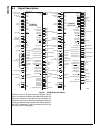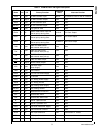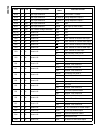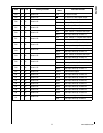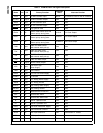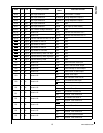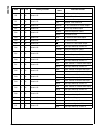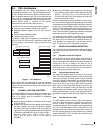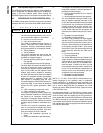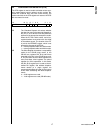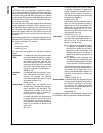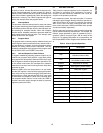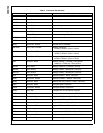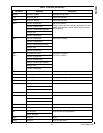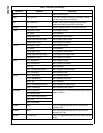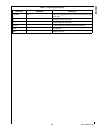
www.national.com 16
CP3BT26
5.2.4 Interrupt Base Register (INTBASE)
The INTBASE register holds the address of the dispatch ta-
ble for exceptions. The dispatch table can be located any-
where in the CPU address space. When loading the
INTBASE register, bits 31 to 24 and bit 0 must written with 0.
5.3 PROCESSOR STATUS REGISTER (PSR)
The PSR provides state information and controls operating
modes for the CPU. The format of the PSR is shown below.
C The Carry bit indicates whether a carry or bor-
row occurred after addition or subtraction.
0 – No carry or borrow occurred.
1 – Carry or borrow occurred.
T The Trace bit enables execution tracing, in
which a Trace trap (TRC) is taken after every
instruction. Tracing is automatically disabled
during the execution of an exception handler.
0
– Tracing disabled.
1 – Tracing enabled.
L The Low bit indicates the result of the last
comparison operation, with the operands in-
terpreted as unsigned integers.
0
– Second operand greater than or equal to
first operand.
1 – Second operand less than first operand.
U The User Mode bit controls whether the CPU
is in user or supervisor mode. In supervisor
mode, the SP register is used for stack opera-
tions. In user mode, the USP register is used
instead. User mode is entered by executing
the Jump USR instruction. When an exception
is taken, the exception handler automatically
begins execution in supervisor mode. The
USP register is accessible using the Load
Processor Register (LPR/LPRD) instruction in
supervisor mode. In user mode, an attempt to
access the USP register generates a UND
trap.
0
– CPU is executing in supervisor mode.
1
– CPU is executing in user mode.
F The Flag bit is a general condition flag for sig-
nalling exception conditions or distinguishing
the results of an instruction, among other
thing uses. For example, integer arithmetic in-
structions use the F bit to indicate an overflow
condition after an addition or subtraction oper-
ation.
Z The Zero bit is used by comparison opera-
tions. In a comparison of integers, the Z bit is
set if the two operands are equal. If the oper-
ands are unequal, the Z bit is cleared.
0
– Source and destination operands un-
equal.
1 – Source and destination operands equal.
N The Negative bit indicates the result of the last
comparison operation, with the operands in-
terpreted as signed integers.
0
– Second operand greater than or equal to
first operand.
1 – Second operand less than first operand.
E The Local Maskable Interrupt Enable bit en-
ables or disables maskable interrupts. If this
bit and the Global Maskable Interrupt Enable
(I) bit are both set, all interrupts are enabled.
If either of these bits is clear, only the non-
maskable interrupt is enabled. The E bit is set
by the Enable Interrupts (EI) instruction and
cleared by the Disable Interrupts (DI) instruc-
tion.
0
– Maskable interrupts disabled.
1 – Maskable interrupts enabled.
P The Trace Trap Pending bit is used together
with the Trace (T) bit to prevent a Trace (TRC)
trap from occurring more than once for one in-
struction. At the beginning of the execution of
an instruction, the state of the T bit is copied
into the P bit. If the P bit remains set at the end
of the instruction execution, the TRC trap is
taken.
0
– No trace trap pending.
1
– Trace trap pending.
I The Global Maskable Interrupt Enable bit is
used to enable or disable maskable interrupts.
If this bit and the Local Maskable Interrupt En-
able (E) bit are both set, all maskable inter-
rupts are taken. If either bit is clear, only the
non-maskable interrupt is taken. Unlike the E
bit, the I bit is automatically cleared when an
interrupt occurs and automatically set upon
completion of an interrupt handler.
0
– Maskable interrupts disabled.
1 – Maskable interrupts enabled.
Bits Z, C, L, N, and F of the PSR are referenced from as-
sembly language by the condition code in conditional
branch instructions. A conditional branch instruction may
cause a branch in program execution, based on the value of
one or more of these PSR bits. For example, one of the
Bcond instructions, BEQ (Branch EQual), causes a branch
if the PSR.Z bit is set.
On reset, bits 0 through 11 of the PSR are cleared, except
for the PSR.E bit, which is set. On warm reset, the values of
each bit before reset are copied into the R2 general-pur-
pose register. Bits 4 and 8 of the PSR have a constant value
of 0. Bits 12 through 15 are reserved. In general, status bits
are modified only by specific instructions. Otherwise, status
bits maintain their values throughout instructions which do
not implicitly affect them.
15 12 11 10 9 8 7 6 5 4 3 2 1 0
Reserved I P E 0 N Z F 0 U L T C



